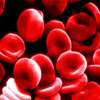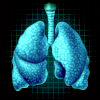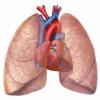Tag: lungs

Here is Why COPD Disrupts Lung-Repair Ability
In chronic obstructive pulmonary disease (COPD), the patients' lungs lose their ability to repair damage on their own. Scientists at the Helmholtz Zentrum München, partner in the German Center for Lung Research, now... read more

Upright CT for lung cancer therapy planning used at Chicago Proton Center
The Northwestern Medicine Chicago Proton Center will be the first proton center in the U.S. to use P-Cure new P-ARTIS CT on patients being treated for lung cancer. Traditionally, patients lie flat on their backs during CT... read more

A closer step to artificial blood
Researchers have created an artificial red blood cell that effectively picks up oxygen in the lungs and delivers it to tissues throughout the body. This artificial blood can be freeze-dried, making it easier for combat medics... read more
Pulmaquin Looks Promising for Treating Lung Infections in Non-CF Bronchiectasis Patients
Aradigm has announced top-line results from two Phase 3 clinical trials of Pulmaquin (inhaled ciprofloxacin) for the treatment of patients with non-cystic fibrosis bronchiectasis (non-CF BE) who have chronic lung infections... read more

Potentially modifiable factors contributing to outcome from acute respiratory distress syndrome
Higher PEEP, lower peak, plateau, and driving pressures, and lower respiratory rate are associated with improved survival from ARDS.... read more

Recruitment manoeuvres for adults with acute respiratory distress syndrome receiving mechanical ventilation
Ten trials met the inclusion criteria for this review (n = 1658 participants). We found five trials to be at low risk of bias and five to be at moderate risk of bias.... read more
Devil in the details: Endotracheal tube depth
According to Napoleon, "the moment of greatest vulnerability is the instant immediately after victory." In airway management, this instant occurs immediately after placement of the endotracheal tube.... read more

New technique keeps donor lungs viable longer
A technique that allows lungs destined for transplants to be preserved longer works well, a new Canadian study finds.... read more

Potentially modifiable factors contributing to outcome from acute respiratory distress syndrome: the LUNG SAFE study
Higher PEEP, lower peak, plateau, and driving pressures, and lower respiratory rate are associated with improved survival from ARDS.... read more

Can a CT Scan Determine Lung Age?
A recent study in the American Journal of Respiratory and Critical Care Medicine sought to characterize age-related lung changes using CT.... read more

New Treatment Guidelines for Rare Lung Disease
Clinical practice guidelines created for the treatment and diagnosis of lymphangioleiomyomatosis (LAM).... read more

COPD epidemic could overwhelm healthcare systems within two decades
Health authorities should brace themselves for an epidemic of chronic obstructive pulmonary disease (COPD) over the next two decades, despite a decline in smoking rates, according to a new study from the University of British... read more

Elevated HDL levels predict reduced lung function
Having an elevated level of high-density lipoprotein cholesterol (HDL-C) is associated with an increased rate of lung function decline over time, according to results from a cohort analysis of more than 30,000 adults presented... read more

What Is Walking Pneumonia, and How Is It Different Than Regular Pneumonia?
Walking pneumonia may sound scary, but it just means a mild case of pneumonia - the patient is "walking" around instead of lying in bed or in a hospital. Hillary Clinton is just one of an estimated 4 to 5 million... read more




